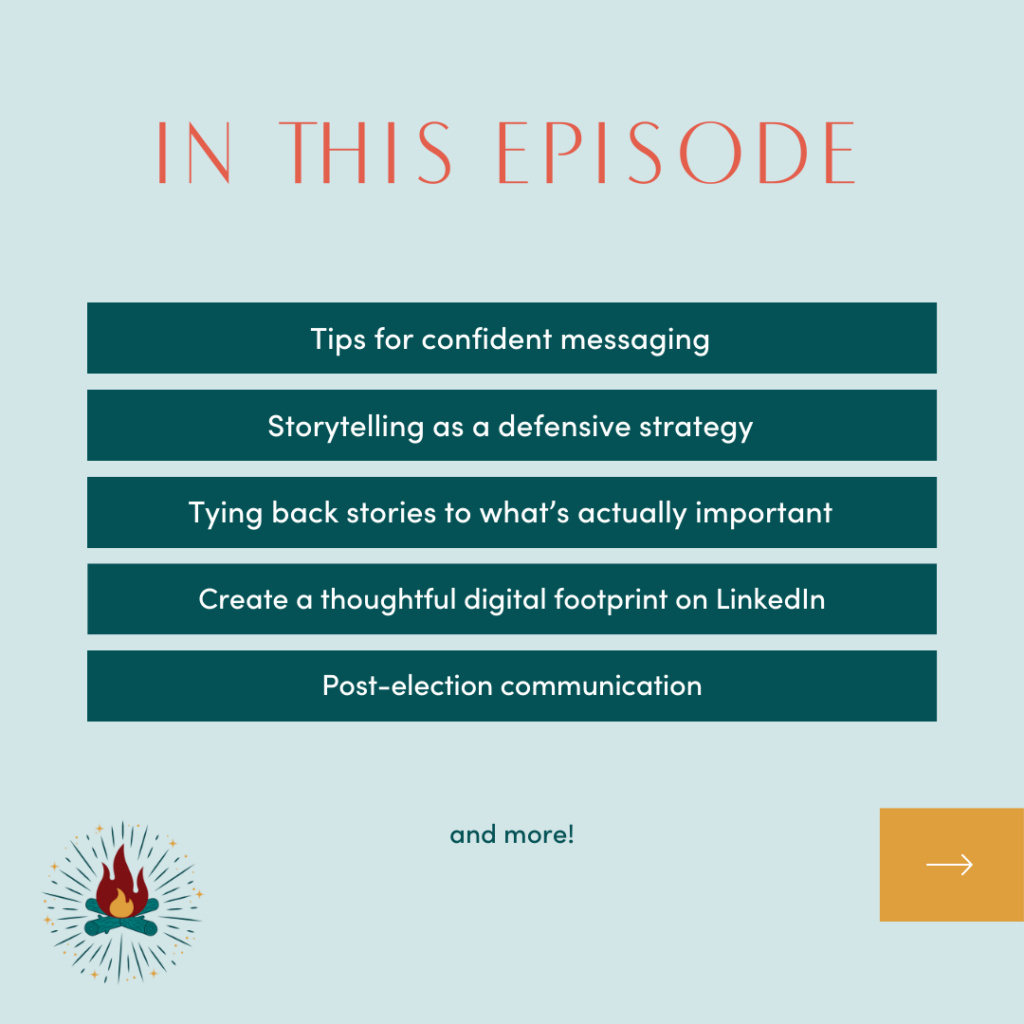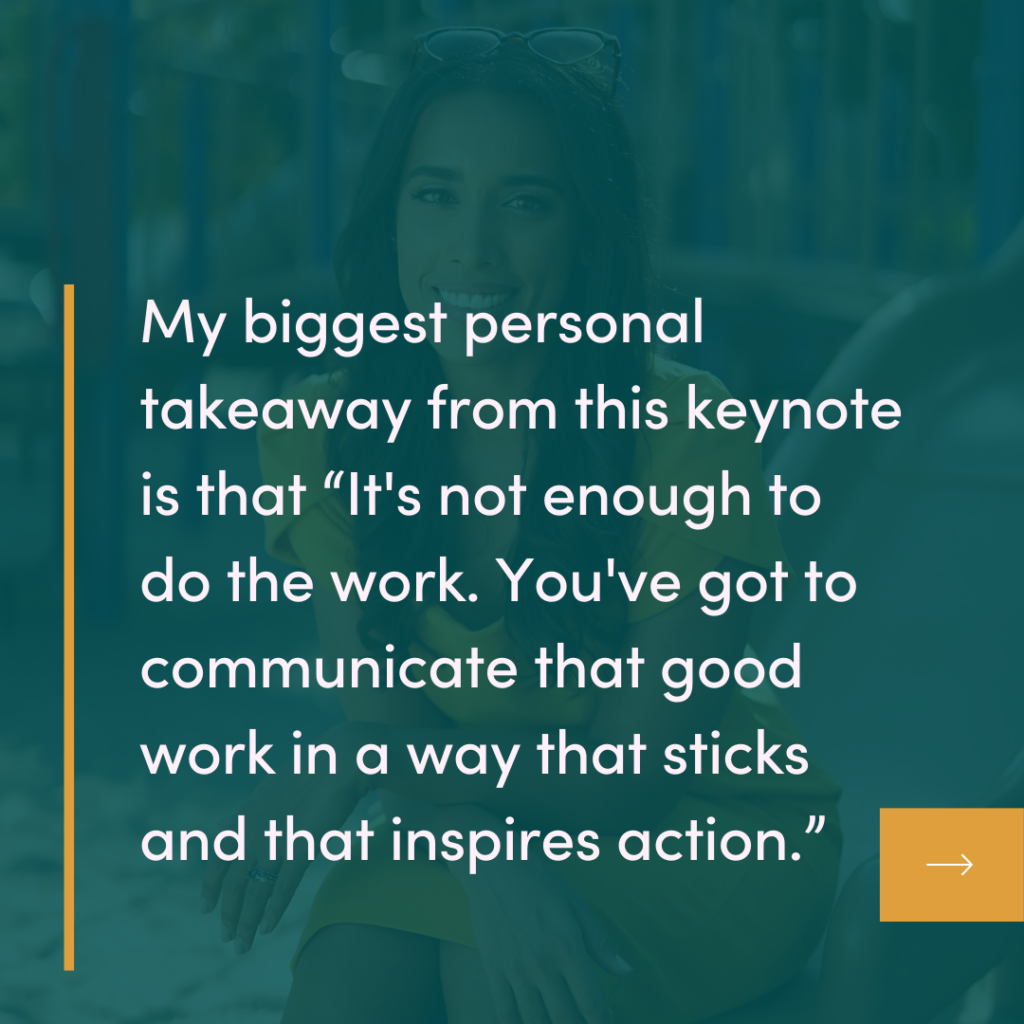I just got back from the Communications Network conference in Kansas City! I did a webinar with ComNet back in May all about LinkedIn for Social Impact Communicators, and I’ll link that YouTube video in the Show Notes. But after that, I realized … this is my community!
And when I learned 1,000 social impact communicators – meaning folks who are dedicated to storytelling that drives conversations about the nonprofits, foundations, and consulting firms they work at, were all getting together in October, I booked my flight immediately.
In this episode, while the conference is fresh in my mind, I wanted to recap some of the main takeaways I took from the sessions I attended and then share 1 or 2 practical applications about how these learnings can influence your visibility strategy, specifically for your thought leadership on LinkedIn.
*In the episode, I accidentally say “offensive” instead of “defensive” when talking about my second takeaway – my error!*
Highlights from the podcast episode:

How to communicate more effectively
The first learning session I attended was the opening keynote, by Jonah Berger who’s an author and Wharton School professor of marketing. By the way, all of the information for the session speakers is going to be in the Show Notes so you can learn more about them and their work – I encourage you to check that out after you’ve listened to the episode.
My biggest personal takeaway from this keynote was that it’s not enough to do good work, you’ve got to communicate that good work in a way that sticks and inspires action and you can do that through language, or what he calls “magic words” – he has a book of the same title. The language you use can act like a stop-sign, or a scroll-stopper. A thumb-brake, maybe? The other, related, takeaway is the importance of confidence in your communications and how it can create trust. To speak in more absolutes and certainty.
So, my practical application for you is to re-read anything you’re putting out into the world as thought leadership – that could be LinkedIn content, or an op-ed, or a speech, and actively get rid of what I call “gremlin words.” In his keynote, Professor Berger called them hedges – we limit our language and try to reduce risk through adding phrases like “I’m not sure if it’ll work but …” Or actual words like “just,” “little,” “kind of,” or “somewhat.”
These words don’t really add much to our sentences; instead, they dilute the impact and power of what we’re trying to say. It feels gentler somehow to use “just” or “little,” but they’re not serving us—they’re simply cluttering our message. I call them “gremlin words” because it reminds me of the 80’s movie where these little, adorable, soft-looking creatures end up wreaking havoc on a whole town.
Gremlin words naturally slip into my speech. When I’m talking, I realize I’ve just been sort-of conditioned to add these softening words into my language. But when writing social impact communications, we can edit them out after we’ve written our first draft. Don’t worry about editing as you go—just get your thoughts down first, and then refine them later. This simple step will make your content sharper and more direct and stronger as a result.
Storytelling as a defensive strategy
The next session I attended was “Build Trust with Better Stories” by the good folks at the Center for Public Interest Communications and the Council on Foundations. And all their info is linked in the Show Notes.
The big a-ha takeaway I had from this session is that, “If you don’t tell your own story, someone else will tell your story for you.” In the session, this was in the context of how most Americans don’t really understand what foundations do, partially because many of us use “philanthro-speak” or jargon in their communications. Their session had some great information for foundations to create shared narratives to counter harmful ones, or at least misunderstood ones.
My practical application I have for you, though, is to think about storytelling as not just a nice-to-have marketing tactic but a key defensive strategy. At some point, whether we’re talking about your organization or you personally, there may be an orchestrated campaign against your work, whether that work is in reproductive rights or climate or voter engagement, or anything else that has found itself under attack in these last few years. Personally, I’ve known quite a few women over the last year who have been unfortunately either removed or forced to leave their organizations, not because of their lack of skill or talent but because they chose to stand up for what they believed in, loudly, and that didn’t sit well with someone on the board or ruling ‘regime.’
There is so much to say about this trend or pattern but I’ll just say, in those kinds of cases, having an ongoing practice of transparently sharing your own story, beliefs, perspectives, opinions, and building a community around you who – whether they agree or not – know the content of your character through your sharing of stories, that can create some level of both protection and position you in your larger community, in the way you want and should be seen.
Telling Better Stories
Next, I attended a session with Kate Tellers at The Moth. In case you’re not familiar with the Moth, it’s a nonprofit dedicated to promoting the art and craft of storytelling, presenting stories told live and without notes – and those stories honor and celebrate the diversity and commonality of human experience.
Obviously I had LOTS of takeaways from this session, which was so good, but the one I will leave you with is that one person can be sharing their story, but everybody can be feeling the same thing – and that happens from connecting your story to its deeper meaning.
Getting into practical applications, I think a lot of us know we’re supposed to share on LinkedIn after something happens, like we attend a committee meeting or get a new grant or enter into a new partnership with a school. But it’s one thing to just share that information, and another thing to go deeper into the meaning of why it’s important to you specifically. How did this make you feel and why? How does what’s happening at your organization tie back to your own personal story, and values, and your “why?” Taking a few extra moments or actually getting into the habit of deep reflection and letting the real juicy bits emerge will help your communications land in a human-to-human way.
The other big takeaway I had was when Kate said, “Stories beget stories.” And so the practical takeaway is to create a culture of storytelling and/or reflection at your organization so that people have opportunities to share mini-stories of what’s going on in their work world, within your small group or team. It creates cross-functional relationship yes and it also builds a habit and practice of reflecting back on stories that are important to the work.
Build your Digital Footprint
Next I heard from Sree Sreenivasan, the CEO of Digimentors who talked about how we each have 2 footprints – 1 is physical and the other is digital. While this may seem somewhat obvious at first blush, this is something that I’ve been trying to put into words and reflect back to social impact leaders for a long time.
I know so many nonprofit CEO’s, social impact consultants, philanthropy leaders, etc, who are extremely networked in-person. They could make a call and reach almost anybody they needed to, to get something done, or at least they know someone who know someone who could reach them. They have years or decades of relationships they’ve built, through in-the-trenches work, serving on committees, attending conferences, and all that stuff. But they have no presence on LinkedIn.
Sure, you could argue like, “Well, but they’re doing fine right? Maybe they don’t need to be on there.” But what I would say is, can you imagine the increased impact they could have if they just started to build their digital footprint, just in one place, re-purposing the stuff they already have, like presentations, op-eds, and the stories the people around them know and love? You could reach an untapped group of people – the ones who know and trust the people who know and trust you. Sure, you have great relationships with the companies who sponsor your fundraising events every year. But by creating a thoughtful digital footprint on LinkedIn, you can reach their friends who run different companies, who should know about your work too and have the resources to support it. Just one example.
Use your voice before, during, and after the election
And finally, the last session I attended was about Post-Election Communications Strategies which was so timely and rich. And this was presented by the good folks at Democracy Fund. And I actually took the most notes in this session. It’s hard to pick one takeaway. But I will pick this one, which is also a practical thing: work now to prepare pre-drafted, pre-vetted, and pre-approved messaging that is ready to go from your leadership, for either situation, always tying the election back into how it connects to the issue you work on. And if you’re working in the social impact space, it does connect to the issue you work on, somehow, somewhere. And that means you have a voice on it.
Of course, if you are a 501c3, you must do so in a nonpartisan way and this session was full of helpful tips and lessons on how to do that – like to base your messaging on the facts, not implying any kind of preference, not using party talking points, and to ideally be in lock-step with legal support who is there to advise you. Also, the content your team shares on LinkedIn, if your organizational name is attached to their profile and they are known as a representative of your organization, falls under this too. However, the other big takeaway I heard loud and clear from this session was that yes, there is risk for 501c3s to say something as it relates to this political moment, but there’s also risk of not saying something, too. This is a critical mission moment, so find your voice.
This whole conference was awesome and if you are involved with communications at a social impact organization, I highly recommend it. It’s going to be in Denver next year, Oct 15 – 17, 2025 and I’ll add that link in the Show Notes too. There’s some early bird pricing right now too. If you were at the conference, I’d love to hear your takeaways too so reach out!

Other Campfire Circle podcast episodes I recommend:
Catch up with last episode: Episode 66: Using LinkedIn to create your conference networking strategy
Episode 53: 10 Copy Coaching Tips for Engaging LinkedIn Content
Connect with Tania Bhattacharyya:
LinkedIn: Tania Bhattacharyya
+ show Comments
- Hide Comments
add a comment